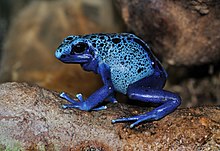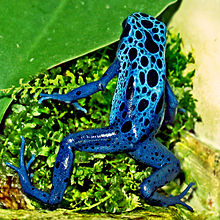| This article needs additional citations for verification. Please help improve this article by adding citations to reliable sources. Unsourced material may be challenged and removed. Find sources: "Blue poison dart frog" – news · newspapers · books · scholar · JSTOR (August 2023) (Learn how and when to remove this message) |
Species of amphibian
| Blue poison dart frog | |
|---|---|

| |
| Conservation status | |
| Not evaluated (IUCN 3.1) | |
| Scientific classification | |
| Domain: | Eukaryota |
| Kingdom: | Animalia |
| Phylum: | Chordata |
| Class: | Amphibia |
| Order: | Anura |
| Family: | Dendrobatidae |
| Genus: | Dendrobates |
| Species: | D. tinctorius |
| Subspecies: | D. t. "azureus" |
| Trinomial name | |
| Dendrobates tinctorius "azureus" (Hoogmoed, 1969) | |
The blue poison dart frog or blue poison arrow frog (Dendrobates tinctorius "azureus") is a poison dart frog found in the "forest islands" surrounded by the Sipaliwini Savanna in southern Suriname. Its indigenous Tiriyo name is okopipi. The name "azureus" comes from its azure blue color. While first described as a valid species and usually recognized as such in the past, recent authorities generally treat it as a morph of D. tinctorius, although a few treat it as a subspecies of D. tinctorius or continue to treat it as its own species. To what extent it differs from the blue D. tinctorius in southern Guyana, adjacent Pará (Brazil) and possibly far southwestern Suriname, is also a matter of dispute, and many herpetologists, as well as many people keeping poison dart frogs in captivity, have not distinguished these, with all commonly being identified as "azureus".
Description

The blue poison dart frog is a medium-sized poison dart frog that weighs about 8 g (0.28 oz) and grows to 3.0–4.5 cm (1.2–1.8 in) in snout–vent length. Females are larger and on average about half a centimetre longer than males, but males have larger toes. Its bright blue skin, usually darker around its limbs and stomach, serves as a warning to predators. The glands of poisonous alkaloids located in the skin serve as a defence mechanism to potential predators. The black spots are unique to each frog, enabling individuals to be identified. In addition to differing in color, blue poison dart frogs also tend to have a distinctive hunch-backed posture and a relatively smaller, more oval (less round) tympanum than in other variants of dyeing poison dart frog. Each foot has four toes, which each have a flattened tip with a suction cup pad used for gripping. The tips of the toes in females are round, while males have heart-shaped tips.
Their tadpoles have a long tail, about 6 mm, with a total length of around 10 mm. They lack legs and have gills instead of lungs.
Behavior

The blue poison dart frog is a terrestrial animal, but, as an amphibian, stays close to water sources. These frogs spend most of their active hours hopping around in short leaps, looking for insects. They are very territorial and aggressive, towards both their own species and others, much like other poison dart frogs. To ward off intruders, they use a series of calls, chases, and wrestling.
Although poison dart frogs are known for their skin toxins used on the tips of hunting-arrows of natives, in reality only the species of the genus Phyllobates are used in this manner. In nature, poison dart frogs consume specific insects, such as small beetles or ants, which contain formic acid (among other alkaloids), which the frogs are able to metabolize and retain as a defense mechanism. Thus, all captive and captive-bred dart frog specimens, including wild-collected individuals, lose their toxicity as a result of a change in diet.
Reproduction
The blue poison dart frog breeds seasonally, usually during February or March when the weather is rainy. To find mates, the males sit on a rock and produce quiet calls, which the females follow to track down the males. The females then physically fight over a male. The male takes the female to a quiet place by the water, which becomes the site of the egg-laying. Fertilization occurs externally; once the eggs are laid, the male covers them in his sperm.
Between five and ten offspring are produced at each mating. Eggs are laid in the male's territory, which he defends. The male takes care of the eggs, sometimes joined by the female. The eggs hatch after 14 to 18 days, and after 10 to 12 weeks the tadpoles are fully mature. Both sexes reach sexual maturity at two years of age. The expected lifespan of D. tinctorius "azureus" is between 4 and 6 years in the wild and about 10 years in captivity.
Feeding
The blue poison dart frog feeds on fire ants and insects which may have poisonous chemical which makes the blue poison dart frog poisonous. Other than that it also feeds on beetles, flies, mites, spiders, termites, maggots, and caterpillars.
Captive care
See also: History of dendrobatid frogkeepingIn captivity, like most captive dart frogs, they eat a staple diet of fruit flies, pinhead crickets, rice flour beetle larvae, isopods, and springtails.
References
- ^ Philippe Gaucher; Ross MacCulloch (2010). "Dendrobates tinctorius". IUCN Red List of Threatened Species. 2010: e.T55204A11265402. doi:10.2305/IUCN.UK.2010-2.RLTS.T55204A11265402.en.
- ^ Wollenberg, Katharina C.; Veith, Michael; Noonan, Brice P.; Lötters, Stefan (2006). Quattro, J. M (ed.). "Polymorphism Versus Species Richness—systematics of Large Dendrobates from the Eastern Guiana Shield (Amphibia: Dendrobatidae)". Copeia. 6 (4): 623. doi:10.1643/0045-8511(2006)6[623:PVSROL]2.0.CO;2. S2CID 51861356.
- ^ d'Orgeix, C.A.; Hardy, D.; Witiak, S.M.; Robinson, L.R.; Jairam, R. (2019). "The Blue Dyeing Poison-Dart Frog, Dendrobates tinctorius (Dendrobates azureus, Hoogmoed 1969): extant in Suriname based on a rapid survey". Amphibian & Reptile Conservation. 13 (2): 259–264.
- Hoogmoed, M.S. (2019). "Unpublished population data of Dendrobates azureus Hoogmoed 1969 obtained in 1968 and 1970, and its historical and current taxonomic status". Amphibian & Reptile Conservation. 13 (2): 95–101.
External links
[REDACTED] Media related to Dendrobates azureus at Wikimedia Commons
| Taxon identifiers | |
|---|---|
| Dendrobates azureus | |